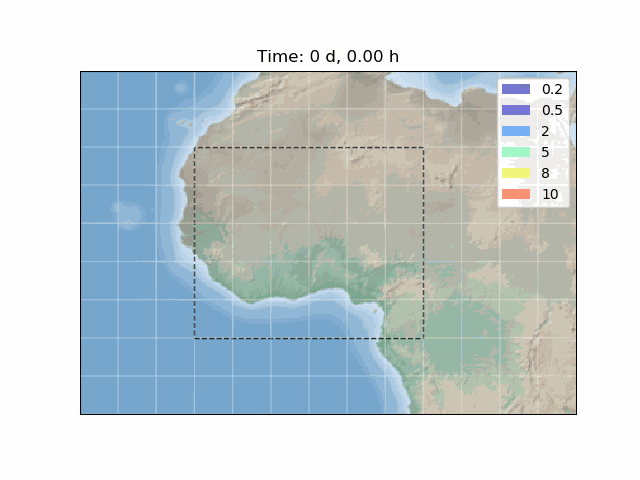
Dr.-Ing. Matthias Fischer
Postanschrift:
Karlsruher Institut für Technologie
Institut für Technische Mechanik
Teilinstitut Dynamik/Mechatronik
Postfach 6980
76049 KarlsruheHaus- und Lieferanschrift:
KIT-Campus Süd
Institut für Technische Mechanik
Teilinstitut Dynamik/Mechatronik
Geb. 10.23, 2.OG
Kaiserstraße 10
76131 Karlsruhe
Surrogate models for uncertainty quantification for the forecast of the West African Monsoon
Surrogate modeling is a method that can be applied if quantities of interest cannot be easily directly measured or simulated, e.g. if a simulation run or experiment is very expensive. In this case, a surrogate model for the outcome is obtained and used instead. Due to increasing complexity of models, surrogate modeling is playing an increasing role in various engineering, but also other scientific disciplines. In this work, a meteorological problem is analyzed in collaboration with the Institute of Meteorology and Climate Research - Department Troposphere Research at KIT.
The West African monsoon is a major wind system that affects regions between latitudes 9° and 20° N. The monsoon is the result of the seasonal shifts of the ITCZ (Intertropical Convergence Zone) and seasonal temperature and humidity differences between the Sahara and the equatorial Atlantic Ocean. The forecast of this monsoon has shown to suffer from remarkable uncertainties in several quantities. Some of these quantities are the local rainfall and the north-south shift which have a great impact on the inhabitants, particularly on the agriculture. In order to quantify the uncertainty in the forecast of the West African monsoon, a sensitivity analysis for a range of uncertain parameters in the weather model is conducted.
For this study the ICON model which is operationally used by the Deutscher Wetterdienst (DWD) is applied to carry out weather simulations. Since for the analysis a steady state for the monsoon quantities over simulated days is intended, the simulated time and thus the computational cost for one simulation run is very high. Therefore, surrogate models seem to be a promising opportunity. In this work, Gaussian Process Surrogates are used to achieve a relation between input parameters and monsoon quantities. The surrogate model is then used to carry out a global sensitivity analysis given defined ranges and probability density functions for all parameters. The results can offer an indication which parameter definitions should be specified more detailed by conducting further studies in order to reduce the uncertainty in forecasted monsoon quantities. Furthermore, the surrogate model can serve as a basis for parameter identification studies.
Contact: Prof. C. Proppe, M. Fischer
Publications
Fischer, M. A.
2025. KIT Scientific Publishing. doi:10.5445/KSP/1000182604
Fischer, M. A.
2025, June 11. Karlsruher Institut für Technologie (KIT). doi:10.5445/IR/1000182304
Fischer, M.; Knippertz, P.; Proppe, C.
2025. Weather and Climate Dynamics, 6 (1), 113 – 130. doi:10.5194/wcd-6-113-2025
Fischer, M.; Knippertz, P.; Linden, R. van der; Lemburg, A.; Pante, G.; Proppe, C.; Marsham, J. H.
2024. Weather and Climate Dynamics, 5 (2), 511–536. doi:10.5194/wcd-5-511-2024
Fischer, M.; Knippertz, P.; Linden, R. van der; Lemburg, A.; Pante, G.; Proppe, C.; Marsham, J. H.
2024. 104th AMS Annual Meeting (2024), Baltimore, MD, USA, January 28–February 1, 2024
Fischer, M.; Proppe, C.
2023. 5th ECCOMAS Thematic Conference on Uncertainty Quantification in Computational Sciences and Engineering, UNCECOMP 2023, Ed.: M. Papadrakakis, National Technical University of Athens (NTUA)
Fischer, M.; Proppe, C.
2023. doi:10.48550/arXiv.2307.06906
Fischer, M.; Proppe, C.
2023. Probabilistic Engineering Mechanics, 74, Art.-Nr.: 103486. doi:10.1016/j.probengmech.2023.103486
Fischer, M.; Knippertz, P.; Linden, R. van der; Lemburg, A.; Pante, G.; Proppe, C.
2022. European Geosciences Union General Assembly (EGU 2022), Online, May 23–27, 2022. doi:10.5194/egusphere-egu22-7470
Fischer, M.; Proppe, C.
2021. UNCECOMP 2021: 4th ECCOMAS Thematic Conference on Uncertainty Quantification in Computational Sciences and Engineering. Ed.: M. Papadrakakis, 246–257, National Technical University of Athens (NTUA). doi:10.7712/120221.8036.18925
Betreute Lehrveranstaltungen
| WS 23/24 | Übungen zu Technische Mechanik III |
| SS 23 | Übungen zu Maschinendynamik |
| WS 22/23 | Übungen zu Einführung in nichtlineare Schwingungen |
| SS 22 | Übungen zu Maschinendynamik |
| WS 21/22 | Übungen zu Modellbildung und Simulation |
| SS 2021 | Übungen zu Maschinendynamik |
| WS 19/20 | Übungen zu Modellbildung und Simulation |
| SS 2020 | Übungen zu Maschinendynamik |
| WS 19/20 | Übungen zu Modellbildung und Simulation |

